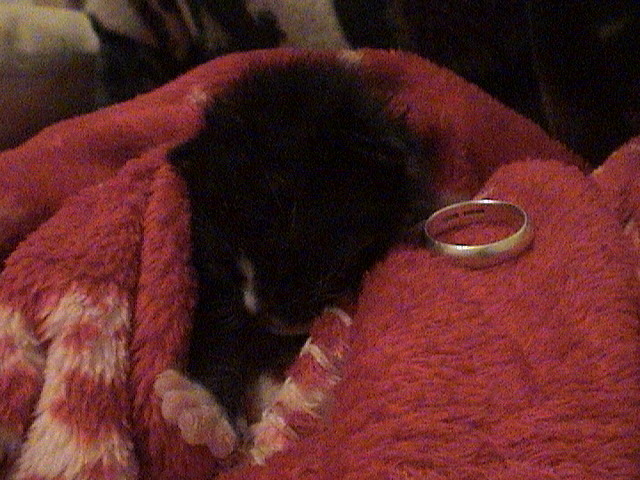QuestionQUESTION: I have a 6yr old female indoor only cat.I am trying to introduce a male 8 week old to our home.
My older cat is hissing at everybody and then hiding under the bed in my 6yr old son's room,and only comes out to eat and go to the bathroom,and then occasionally when she feels comfortable.Around the new kitten
My older cat is very shy.
I have had cats my whole life and have never seen this kind of reaction before in introducing a new kitten/cat.
Any help would be greatly appreciated
ANSWER: Micheal,
Questions about new cat/kitten introductions are very common and I have answered countless questions on this subject so I will give you the short version of how to properly introduce the new kitten to your resident cat. You are free to fill in the details by checking out my previous answers on this subject. Cats are very territorial and they tend not to appreciate change so it's important to be sensitive to that fact when adding a new cat or kitten to the family. When introducing a new cat/kitten into a home with one or more resident cats it's important to isolate the new family member in a room behind a closed door with all of the usual kitty amenities and regular attention for a minimum of 2-3 weeks. This initial period of confinement serves a few purposes, firstly it allows the new kitty to be quarantined and avoids the possible spread of viral or bacterial infections to resident cats. By isolating the new kitty you also have the opportunity to get to know your new family member as well as what is normal in terms of appetite, litter box habits and personality. It sounds as though your older cat is either very shy or feeling under the weather. It would probably be wise to have the vet check her over to ensure that there isn't anything happening in terms of her health. Once you've ruled out medical causes for this odd behavior you could try a homeopathic remedy called Bach's Rescue Remedy which is a blend of flower essences designed to calm and reassure. Rescue Remedy can be found in health food stores, naturopathic pharmacies, in some mainstream pharmacies in the section with the vitamins and other nutritional supplements and I believe that you can also purchase this remedy online. I'm not entirely sure how much you know about your older cat's history, she may have fears related to previous bad experiences or she may just be a really submissive cat, although most cats will defend their territory fairly aggressively. Do be careful when handling this kitty to avoid injury because the behavior is odd enough that the cat may become unpredictable and scratch or bite someone who upsets her. If you opt to use Rescue Remedy I would recommend adding 5-7 drops to a fresh bowl of water each morning and if anxiety or previous trauma are the issues you should start to see fairly rapid improvement in this cat's demeanor and behavior. Rescue Remedy is very safe so it won't harm humans, other pets or even young children.
---------- FOLLOW-UP ----------
QUESTION: Thank you very much.I only know that my older female cat I got her from the Humane Society,when she was about 7-8 weeks old,now she is 6yrs old
She has never been very friendly around other people,except for me and my 6yr old son.Friends and family come over and she takes off to go and hide. She does come out just to see but does stay long.
She has only ever had a cold with me,never anything seriously wrong with her
I will give the Bach's a try and and hopefully it will work.How long do I give it too her for ?? Weeks/Months
AnswerMicheal,
You can give Bach remedies long term, I would recommend that you keep giving the Rescue Remedy until the two cats have met again face to face and everything seems to be going well. Once these kids are comfy with one another you can try to eliminate Rescue Remedy, if things start looking nasty you can always start giving Rescue Remedy again.
A few tips for when your two kitties get together on a full time basis:
- Be sure to have more than one feeding station, some cats become possessive and territorial which can lead to other cats in the household being bullied away from the food and water dishes, this can become quite a serious problem.
- I recommend that pet parents have one litter box per cat plus one, and that they are located in different areas (away from the food and water, cats don't like to eat where they go to the toilet). Be sure that the litter trays allow for private, quiet potty time or you may find that one or both of the cats seeks out an alternative area to use as a toilet that you may not approve of. Usually unscented clumping litter is my litter of choice, it doesn't really matter whether it's made from clay, corn, wheat or other materials so long as things are kept clean and the cats are comfortable, after all, nobody wants urine or feces outside of the litter pan.
- It's also quite important that you ensure that your resident cat understands that she isn't being replaced. She needs to understand that the kitten is new and must earn his position in the hierarchy. You may see some low key squabbles, if you do just let them work things out, kitty politics is best observed just in case things get out of hand and intervention is required. Be sure that your older kitty knows that she's still important to you and your son, sometimes giving her extra attention, playing with her using her favorite toy, grooming her in a way that she enjoys or even giving her extra special favorite treats will help her to accept the younger kitty in the household without too much upset. After all, upset kitties can sometimes lead to wet or dirty places outside of the litter pan.
Who knows? Maybe the resident cat will blow everyone away and come out of her shell to become the happy, loving cat that she is inside.
Enjoy your resident cat and your new kitten, I'm sure there will be plenty of antics that will leave everyone happy and content once things settle down some and everyone gets comfortable with the changes in the household.

 Stray kitten
Question
My Kitten
Hi i was wondering how much t
Stray kitten
Question
My Kitten
Hi i was wondering how much t
 Orphaned Kitten
QuestionQUESTION: My partner and l are very much animal
Orphaned Kitten
QuestionQUESTION: My partner and l are very much animal
 What is the breed of my cats
Question
1st
Hello Ali
Thanx for giving us time to get
What is the breed of my cats
Question
1st
Hello Ali
Thanx for giving us time to get
 Chinese Li Hua?
Question
Magnus1
Hi,
My husband and I recently
Chinese Li Hua?
Question
Magnus1
Hi,
My husband and I recently
 3x week visiting cat
Question
banjo and Joppy
Hi thanks for maybe bei
3x week visiting cat
Question
banjo and Joppy
Hi thanks for maybe bei